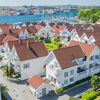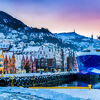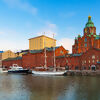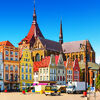26 Nights | VIKING TRAILS
You will visit the following 20 places:

Norway
Norway is the westernmost, northernmost—and in fact the easternmost—of the three Scandinavian countries. Best known for the complex and deep fjords along its west coast which stretches from the North Sea near Denmark and Scotland into the Arctic Ocean and has borders with Finland, Sweden and the northwestern tip of Russia. Norway may have a clutch of attractive, cosmopolitan cities, appealing destinations in their own right, but where the country really shines is not in its urban culture, but rather in the low-key, amiable small-town feel that pervades throughout its settlements.

Copenhagen
Copenhagen is the capital and largest city of Denmark. This "friendly old girl of a town" is big enough to be a metropolis with shopping, culture and nightlife par excellence, yet still small enough to be intimate, safe and easy to navigate. Overlooking the Øresund strait with Sweden just minutes away, it is a cultural and geographic link between mainland Europe and Scandinavia. This is where old fairy tales blend with flashy new architecture and world-class design; where warm jazz mixes with cold electronica from Copenhagen's basements. You'll feel you've seen it all in a day, but could keep on discovering more for months. Copenhagen is considered a very liveable place because of its cleanliness. It’s considered as one of the very environmentally friendly cities because its harbour can be swum in and about a third of the city’s people use bicycles as their means of transportation. In their downtown area, the places to visit and to be entertained at are the Tivoli gardens and the Town Hall Square. If you want the very cultural and scenic areas the places to see are the Marble church, the Rosenborg castle, and the Christiansborg.

Stavanger
Stavanger is a city and municipality in Norway. The urban area of Stavanger stretches across many neighboring municipalities, making it the third largest city in Norway by total urban population with 197 852 inhabitants as of January 1, 2011. Stavanger's core is to a large degree 18th- and 19th-century wooden houses that are protected and considered part of the city's cultural heritage. This has caused the town centre and inner city to retain a small-town character with an unusually high ratio of detached houses, and has contributed significantly to spreading the city's population growth to outlying parts of Greater Stavanger. The city's rapid population growth in the late 20th century was primarily a result of Norway's booming offshore oil industry. Today the oil industry is a key industry in the Stavanger region and the city is widely referred to as the Oil Capital of Norway. Multiple educational institutions for higher education are located in Stavanger. The largest of these is the University of Stavanger.

St Petersburg
Saint Petersburg is a city and a federal subject (a federal city) of Russia located on the Neva River at the head of the Gulf of Finland on the Baltic Sea. In Russian literature, informal documents and discourse, the word "Saint" is usually omitted, leaving "Petersburg". The city is often described as the most Westernized city of Russia, as well as its cultural capital. It is the northernmost city in the world with a population of over one million. The Historic Centre of Saint Petersburg and Related Groups of Monuments constitute a UNESCO World Heritage Site. The city is home to The Hermitage, one of the largest art museums in the world. A large number of foreign consulates, international corporations, banks, and businesses have offices in Saint Petersburg. Talking of churches, Church of the Savior on the Blood is said to be the most beautiful church in St. Petersburg. Built of beautiful mosaic and stonework, the church gives you an indication of how ancient Russia looked like. The church is built at an equally historic spot. This is where Tsar Alexander II was assassinated in the year 1881.

Gdynia
Gdynia is a city in the Pomeranian Voivodeship of Poland and an important seaport of Gdańsk Bay on the south coast of the Baltic Sea. Gdynia, together with nearby Gdańsk and Sopot are often referred as Tricity (pl: Trójmiasto). Gdynia was first mentioned in the 13th century as a fishing village. Its career began after World War I, when it became Poland´s main harbour and the big sea port at the Baltic Sea, which it still is. Gdynia is one of the youngest and modern cities in Poland. In the early 1900s it was a little village, but after WW1 and establishing the Free City of Gdańsk, the Polish Government decided to build a deep-sea port. Construction began in 1921. The city rose fast in the 1920s and 1930s, so architecture and planning reflect European trends of the day - Modernism. The city continues to grow to this day. Today, Gdynia is a modern city with a population of a quarter-million and is the second major polish port in the Baltic Sea after Gdansk.

Oslo
Oslo is a county and municipality, as well as the capital and largest city in Norway. Oslo was established as a municipality on 1 January 1838. Founded around 1048 by King Harald III "Hardraade" of Norway, the city was largely destroyed by fire in 1624. The Danish–Norwegian king Christian IV moved the city, rebuilding it closer to Akershus fortress, as Christiania (briefly also spelt Kristiania). In 1925, the city reclaimed its original Norwegian name, Oslo. The diocese of Oslo is one of the five original dioceses in Norway, which originated around the year 1070.

Gothenburg
Gothenburg is the second-largest and a major city in Sweden, situated off the Göta älv river on the country's west coast. The City of Gothenburg was founded in 1621 by King Gustavus Adolphus of Sweden. An important seaport, it's famed for its Dutch-style canals and leafy boulevards like the Avenyn, the city's main thoroughfare, lined with many cafes and shops.

Bergen
Bergen is the second largest city in Norway with a population of 261,600 as of April 31, 2011. Bergen is the administrative centre of Hordaland county. Greater Bergen or Bergen Metropolitan Area as defined by Statistics Norway, has a population of 386,900 as of April 31, 2011. Bergen is located in the county of Hordaland on the south-western coast of Norway. It is an important cultural hub in its region, recognized as the unofficial capital of Western Norway and sometimes also referred to as the Atlantic coast capital of Norway. The city was one of nine European cities honoured with the title of European Capital of Culture in the Millennium year.

The Convent Amsterdam
Amsterdam is the capital of the Kingdom of the Netherlands. It is the country's largest city and its financial, cultural, and creative centre. Many large Dutch institutions have their headquarters there, and seven of the world's 500 largest companies, including Philips and ING, are based in the city. In 2012, Amsterdam was ranked the second best city in which to live by the Economist Intelligence Unit (EIU) and 12th globally on quality of living for environment and infrastructure by Mercer. Amsterdam derives its name from the city’s origin as “Dam” of river “Amstel”. In the past, the name was "Amstelredamme" which later changed as “Amsterdam”. The city is one of the most popular destinations in Europe, attracting over 7 million international travellers annually. The city is colloquially known as ''Venice of the North'' because of its lovely canals that criss-cross the city, its impressive architecture and more than 1,500 bridges. There is something for every traveller's taste here; whether you prefer culture and history, serious partying, or just the relaxing charm of an old European city!

Stockholm
Stockholm - Sweden's capital and largest city, and the most populous city in the Nordic region. Without a doubt, Stockholm is one of the most beautiful cities in Europe. The city is made up of 14 islands connected by some 50 bridges on Lake Mälaren, which flows into the brackish Baltic Sea, and passes the Stockholm archipelago with some 24,000 islands and islets. The city is a cosmopolitan place with both classical and modern architecture, and a captivating Old Town, Gamla Stan. Today, the area is an atmospheric mixture of buildings surrounded on all sides by a latticework of medieval lanes and alleyways.

Tallinn
Tallinn is the capital and largest city of Estonia. It occupies an area of 159.2 km2 (61.5 sq mi) with a population of 412,144. It is situated on the northern coast of the country, on the banks of the Gulf of Finland, 80 km (50 mi) south of Helsinki, east of Stockholm and west of Saint Petersburg. Tallinn's Old Town is in the list of UNESCO World Heritage Sites. Tallinn is ranked as a global city and has been listed among the top 10 digital cities in the world. Tallinn is a European Capital of Culture for 2011, along with Turku, Finland.

Helsinki
Helsinki is the capital and largest city in Finland. Finland's major political, educational, financial, cultural, and research center as well as one of northern Europe's major cities, Helsinki was ranked the most liveable city in the world, in 2011. Approximately 75% of foreign companies operating in Finland have settled in the Helsinki region. The nearby municipality of Vantaa is the location of Helsinki Airport, with frequent service to various destinations in Europe and Asia. Today, Helsinki pulls off the trick of being something of an international metropolis while still retaining a small-town feel. The best time to visit is in summer, when Finns peel off their overcoats and flock to outdoor bars and cafes to enjoy the sunshine.

Geiranger

Warnemünde
Warnemünde is a seaside resort and a district of the city of Rostock in Mecklenburg, Germany. It is located on the Baltic Sea and, as the name implies, at the estuary of the river Warnow. Founded in about 1200, Warnemünde was for centuries a small fishing village with minor importance for the economic and cultural development of the region. Today, it's known for its long beachfront and marina, a cruise-ship stop.

Zeebrugge

Klaipeda County

Ålesund

Justvik
Kristiansand, historically Christiansand, is a city and municipality in Norway. It is the fifth largest city in Norway and the municipality is the sixth largest in Norway. Tourism is important in Kristiansand, and the summer season is the most popular for tourists. Kristiansand Zoo and Amusement park is the largest zoo in Norway. It receives over 900,000 visitors every year. Markens Street is the main pedestrian street in downtown Kristiansand. Bystranda is a city beach located in Kvadraturen; in addition, Hamresanden beach is the longest beach in Kristiansand. Hamresanden Camping is a popular family camp during the summer season. The city hosts a free concert in downtown Kristiansand once every week in the summer. Outside the city is the industry park Sørlandsparken, which has Sørlandssenteret, the largest mall in Norway.

Hellesylt










